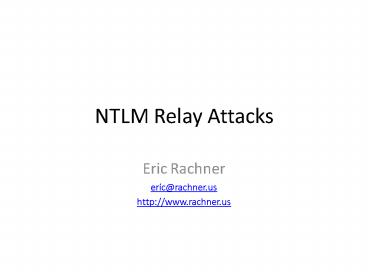NTLM Relay Attacks PowerPoint PPT Presentation
1 / 14
Title: NTLM Relay Attacks
1
NTLM Relay Attacks
- Eric Rachner
- eric_at_rachner.us
- http//www.rachner.us
2
The Relay Attack Scenario
- Assumptions
- In an environment where clients use NTLM to
authenticate to network apps / resources - Attackers machine has a local intranet host
name (e.g., http//laptop or http//laptop209.acme
.com) - Exploitability Impact
- Victim only needs to visit attackers web site
- Attacker can then access arbitrary network
resources using the victims domain account
3
About NTLM
- Part of Windows Integrated AuthN protocol suite
provides AuthN service for a wide variety of
application protocols (HTTP, SMB, TDS aka MS SQL,
Exchange, etc.) - Enabled by default
- Essentially a challenge-response design
- Server transmits challenge / nonce
- Client computes transmits response
- Server verifies correct response w/help of domain
controller
4
The Basic ProblemLack of mutual authentication
A client thinks its authenticating to
http//hacker, but its actually authenticating
to http//targetapp by way of the hackers
machine!
5
History Due Credit
- 2001 First implemented by Sir Dystic of cDc as
SMBRelay - 2004 Jesse Burns of iSec demonstrates updated
SMB-based attack at Black Hat (but doesnt
release the code.) - 2007 Metasploit team re-implements SMB attack,
integrates it into development branch - 2008 HTTP-to-HTTP based attack implemented by
yours truly
6
How It Begins
- rel1autoplay1"
- type"application/x-shockwave-flash"
- wmode"transparent"
- width"425"
- height"355"
- e
- e
- /iframe
7
Demo
8
Incidentally,
- I urge you to consider this a rogue server
problem, and not a man-in-the-middle scenario,
insofar as the attacker does not need to - Poison DNS
- Spoof ARP packets
- Re-route traffic
- Operate a rogue access point
- Exploit the WPAD problem
- or otherwise interpose themselves along the
network path to the targeted server
9
Assumptions, Revisited
- Attacks are easiest if browser authenticates to
attackers machine automatically - Implies Internet Explorer
- Implies a trusted host name for attackers
machine, e.g. http//hacker.acme.com or
http//hacker. This is possible via - DNS auto-registration (favorite host name
wpad) - Attacker on same subnet
10
More Bad News
- Not just an intranet scenario Internet-borne
attacks are possible against internet-facing
applications - Clients in coffeeshops easy targets
- Clients on intranets tougher targets, but
possibly vulnerable in tricky DNS rebinding
scenarios - Credit here goes to natron who proposed the
technique currently being researched in a 2007
email to RSnake
11
In re. Fear, Uncertainty Doubt
- Say, is there any reason this attack couldnt
be leveraged in any scenario where NTLM is
supported? - Handy list of possible targets posted at
http//www.microsoft.com/products/
12
Analysis
- No, SSL is not helpful here.
- NTLMv2 just as vulnerable as NTLMv1
- NTLM has numerous other problems(ref. Jesse
Burns 2004 Moniz Stach, 2005 Grutz, et. al.
2007) - 0-day? More like 2,555-day
- Long story short migrate away from NTLM, ideally
towards Kerberos
13
Wanna Get Scurvy?
- http//www.rachner.us/files/scurvy/
14
Questions?
- Eric Rachner
- eric_at_rachner.us
- http//www.rachner.us

